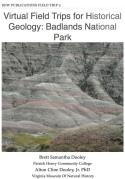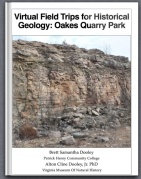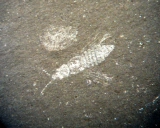 The reason I took Tim to Baraboo for his field lab was that the region has a pretty complex geologic story that has to be inferred from measurements and data collected at multiple stops. There isn’t one locality that we visited that gives the entire story (and, in fact, the whole story is much richer than what I’m about to describe).
The reason I took Tim to Baraboo for his field lab was that the region has a pretty complex geologic story that has to be inferred from measurements and data collected at multiple stops. There isn’t one locality that we visited that gives the entire story (and, in fact, the whole story is much richer than what I’m about to describe).
Looking at what we’ve seen so far in Part 1 and Part 2, we’re dealing with two basic types of rocks. One is primarily a pink quartzite (with some phyllite). Even though the rock has been metamorphosed, ripples and cross bedding are still visible in some places, confirming its sandstone origins. This rock has also undergone some folding, as it was tilted to some degree at every outcrop. The other rock was brown to gray coarse-grained sandstone or conglomerate. The cobbles in the conglomerate layers were made up of quartzite, and these beds tended to lying more or less horizontally.
So what can we say about these rocks? Let’s start with Van Hise Rock, where everything was standing on end.
 In Part 2, I mentioned the cleavage present in Van Hise Rock. That cleavage can give us a lot of information about the rock, because it’s caused by the same stresses that tilted the rock on end. To tilt a rock you need a fold somewhere, and the cleavage fractures fan out around the axis of the fold. The angle varies with different rock types; in non-foliated rocks (like quartzite) it tends to be almost perpendicular to bedding, while in foliated rocks like phyllite the cleavage will tend to approach an angle parallel to the fold axis. For Van Hise Rock, that gives a relationship like this:
In Part 2, I mentioned the cleavage present in Van Hise Rock. That cleavage can give us a lot of information about the rock, because it’s caused by the same stresses that tilted the rock on end. To tilt a rock you need a fold somewhere, and the cleavage fractures fan out around the axis of the fold. The angle varies with different rock types; in non-foliated rocks (like quartzite) it tends to be almost perpendicular to bedding, while in foliated rocks like phyllite the cleavage will tend to approach an angle parallel to the fold axis. For Van Hise Rock, that gives a relationship like this:
 (See Callan Bentley’s post at Mountain Beltway for a similar diagram, and a more detailed description of why the cleavage tends to align this way.)
(See Callan Bentley’s post at Mountain Beltway for a similar diagram, and a more detailed description of why the cleavage tends to align this way.)
In the photo above, north is to the left. That means that the fold could pop up again further south, and in fact it does; Van Hise Rock was our northernmost stop. Moreover, at the southern stops, the quartzite was right side up (based on cross bedding), which tells us that the top surface at Van Hise Rock is to the right (toward the middle of the fold). Since these beds are not quite vertical, but are instead dipping to the northwest, that means Van Hise Rock is slightly overturned.
When trying to describe geologic structures that involve tilted sedimentary rocks, we need some method of describing the orientation of the rocks. Since a sedimentary rock layer is originally a horizontal plane (more or less), we can describe the rock’s orientation by describing how much it varies from a horizontal plane by measuring its strike and dip. Basically, strike is the line formed by the intersection of our tilted rock plane with an imaginary horizontal plane. Dip is how much and which direction the rock plane is tilted around that line, and is perpendicular to the strike line. Strike is indicated on a map by a straight line in the appropriate direction. Dip is indicated by short line at a right angle to the strike line, in the appropriate direction, and with the dip angle write next to the line. So this:
 represents a rock striking 65 degrees east of north (N65E), and dipping 20 degrees to the northwest.
represents a rock striking 65 degrees east of north (N65E), and dipping 20 degrees to the northwest.
Here are the strikes and dips Tim and I measured:
 The two sites in the extreme northwest are Van Hise Rock and Ableman’s Gorge; they have the little loops on the dip symbol to denote that they are overturned. Notice that all the southern sites (Parfrey’s Glen, Highway 12, La Rue Quarry, and Devil’s Lake) are all dipping to the northwest between 16 and 24 degrees.
The two sites in the extreme northwest are Van Hise Rock and Ableman’s Gorge; they have the little loops on the dip symbol to denote that they are overturned. Notice that all the southern sites (Parfrey’s Glen, Highway 12, La Rue Quarry, and Devil’s Lake) are all dipping to the northwest between 16 and 24 degrees.
With this data, we can attempt to draw a cross section showing the structure of the fold below the ground. Here’s a section from Van Hise Rock to the La Rue Quarry, with pink representing the quartzite and browns representing the younger, horizontal sandstones and conglomerates:
 Now, keep in mind that this is a very basic hypothesis based on limited data. Tim and I only measured orientations at 6 spots, and we only took one or two measurements at each place. Moreover, we didn’t measure the thickness of the quartzite, which could have a big effect on the depth and exact shape of the fold. A full-scale mapping project can’t be done in two days by a paleontologist and a high school student! Even so, this gives a basic framework for what we might find below the surface around Baraboo if we were to drill a core.
Now, keep in mind that this is a very basic hypothesis based on limited data. Tim and I only measured orientations at 6 spots, and we only took one or two measurements at each place. Moreover, we didn’t measure the thickness of the quartzite, which could have a big effect on the depth and exact shape of the fold. A full-scale mapping project can’t be done in two days by a paleontologist and a high school student! Even so, this gives a basic framework for what we might find below the surface around Baraboo if we were to drill a core.
So we can now tell the first part of our story. We start with very old sands that were deposited in shallow water, most likely in the ocean fairly close to shore. There was enough wave action to cause regular ripple migration across the seafloor. The sand was buried, lithified into sandstone, and then encountered compressional forces from a tectonic collision that folded and metamorphosed the sandstone into quartzite.
How about the brown sandstones and conglomerates? We can say quite a lot about those as well. Several lines of evidence confirm that they are younger than either the quartzite or the tectonic event that folded the quartzite. For example, the sandstone is not folded at any locality, and at Parfrey’s Glen and Ableman’s Gorge it can be seen to overlie the quartzite. Moreover, at several localities, including Parfrey’s Glen and the La Rue Quarry, pieces of the quartzite can be seen as cobbles in the conglomerate. That means that, when the ocean was depositing the sands that became the brown sandstone, at least part of the quartzite was exposed as islands. Erosion removed pieces of the quartzite and deposited it into the sand. At the La Rue Quarry, part of this ancient, rocky coastline is exposed:
 The breccia consists of large angular blocks of the quartzite that broke off through erosion and fell onto the beach. They are angular because they hardly traveled any distance at all. The generally more rounded cobbles at Parfrey’s Glen experienced more transport and perhaps higher energy waves.
The breccia consists of large angular blocks of the quartzite that broke off through erosion and fell onto the beach. They are angular because they hardly traveled any distance at all. The generally more rounded cobbles at Parfrey’s Glen experienced more transport and perhaps higher energy waves.
So far, I’ve based this entirely on the observations Tim and I made on our trip (admittedly, I had researched the area beforehand and visited Baraboo as a student, so I knew what I was looking for). But if we pull in some geologic map data from the USGS and overlay our measurements, we can see how this fits into the bigger picture:
 The dark green is the Baraboo Quartzite, which is thought to be Proterozoic in age (~1.5 billion years old) (Dott and Dalziel, 1972). The light green are Cambrian sandstones, including the Galesville, Tunnel City, and Jordan Sandstones (there are trace fossils in these units in many localities, although we didn’t see any). The orange areas are igneous rocks that underlie the Baraboo Quartzite and which were used to help constrain the age of the quartzite (Dott and Dalziel, 1972).
The dark green is the Baraboo Quartzite, which is thought to be Proterozoic in age (~1.5 billion years old) (Dott and Dalziel, 1972). The light green are Cambrian sandstones, including the Galesville, Tunnel City, and Jordan Sandstones (there are trace fossils in these units in many localities, although we didn’t see any). The orange areas are igneous rocks that underlie the Baraboo Quartzite and which were used to help constrain the age of the quartzite (Dott and Dalziel, 1972).
Dalziel and Dott (1970) suggested the quartzite formed an island archipelago in the Late Cambrian, and recognized various erosional coastline features such as sea stacks and straits between islands. At that time, North America was rotated about 90 degrees clockwise from its present orientation, and sat on the equator:
(Map is modified from Paleogeography and Geologic Evolution of North America, by Ron Blakey. Here’s the original.)
The Baraboo Islands, indicated by the black arrow above, sat at around 10 degrees south latitude. This would have placed them squarely in the trade winds, which would have blown from right to left in the image above. Indeed, Dalziel and Dott (1970) reported that quartzite grains that can be traced to the Baraboo Quartzite can be found 30 km from the islands, but only on the (present) south side of the islands. The present south side of the islands is the Cambrian west side – downwind. With its tropical location, the Baraboo Islands would also have been subject to battering by tropical storms. Dott (1974) estimated that storm waves up to 8 meters high would have been necessary to tumble the largest rounded boulders found the the conglomerate bordering the quartzite.
There is one more piece to the story. Devil’s Lake is a pretty odd feature from a physiographic standpoint. Here’s an oblique aerial view, looking northwest, in a Google Earth rendering:
 Devil’s Lake fills one leg of a large, L-shaped valley. This valley is the old channel of the Wisconsin River, which currently loops around to the east of Baraboo before curving back to the southwest. Here’s approximately where the river flowed prior to the last Ice Age; the L-bend is where Devil’s Lake is located:
Devil’s Lake fills one leg of a large, L-shaped valley. This valley is the old channel of the Wisconsin River, which currently loops around to the east of Baraboo before curving back to the southwest. Here’s approximately where the river flowed prior to the last Ice Age; the L-bend is where Devil’s Lake is located:
 Remember the low hills blocking each end of Devil’s Lake?
Remember the low hills blocking each end of Devil’s Lake?
 These are part of a much longer ridge that is found throughout the area, and that cuts across the L-shaped valley that includes Devil’s Lake:
These are part of a much longer ridge that is found throughout the area, and that cuts across the L-shaped valley that includes Devil’s Lake:
 We don’t see ridges like this in Virginia, but they’re commonplace in the northern United States and Canada. This is a glacial moraine; essentially, it’s material that was bulldozed by an advancing glacier. The sediment piles up at the front of the glacier, and when the glacier melts, the ridge of sediment is left behind. This is the terminal moraine for the Green Bay Lobe of the Laurentide Ice Sheet, the last big glacial advance during the Ice Age, about 20,000 years ago (Black, 1970):
We don’t see ridges like this in Virginia, but they’re commonplace in the northern United States and Canada. This is a glacial moraine; essentially, it’s material that was bulldozed by an advancing glacier. The sediment piles up at the front of the glacier, and when the glacier melts, the ridge of sediment is left behind. This is the terminal moraine for the Green Bay Lobe of the Laurentide Ice Sheet, the last big glacial advance during the Ice Age, about 20,000 years ago (Black, 1970):
 When the Green Bay Lobe advanced over the eastern part of the Baraboo Hills, it went right over the Wisconsin River drainage, except for a small part where Devil’s Lake is currently located. When the ice retreated, the Wisconsin River established a new channel farther east, but the old channel was left behind and, being dammed in two places by the terminal moraine, partially filled to become Devil’s Lake.
When the Green Bay Lobe advanced over the eastern part of the Baraboo Hills, it went right over the Wisconsin River drainage, except for a small part where Devil’s Lake is currently located. When the ice retreated, the Wisconsin River established a new channel farther east, but the old channel was left behind and, being dammed in two places by the terminal moraine, partially filled to become Devil’s Lake.
There’s still a final piece of the story. There are areas in the Devil’s Lake valley that contain Cambrian sediments. That suggests that this is one of the original channels separating two of the Baraboo islands. When the Wisconsin River flowed through the valley, it didn’t carve the channel entirely on its own; it was following a narrow seaway between two Cambrian islands that had been carved by the ocean 500 million years earlier. Even after all this time, the remnants of the islands still rise above the landscape, as the bluffs that surround Devil’s Lake.











